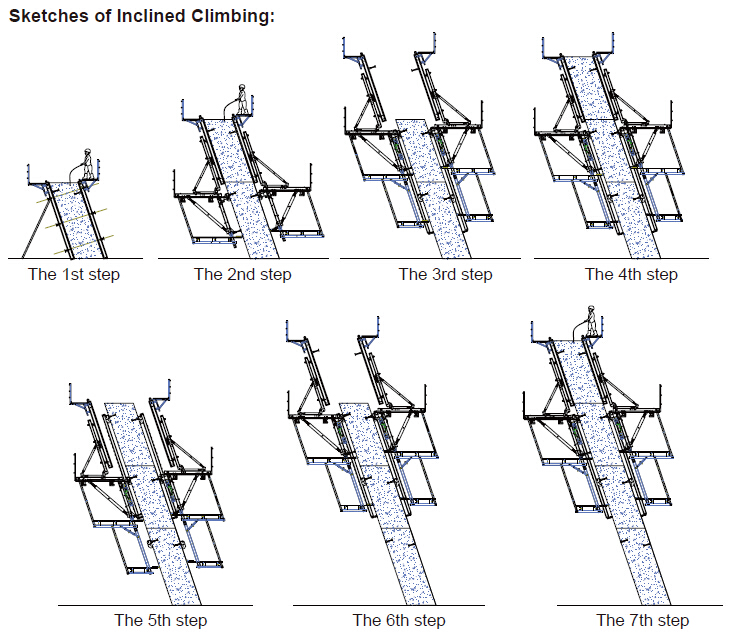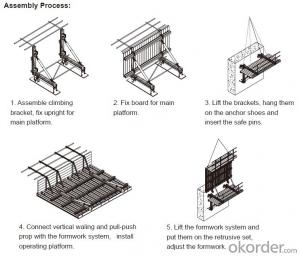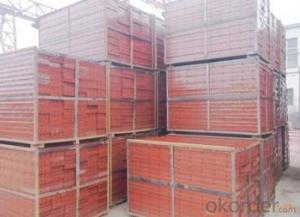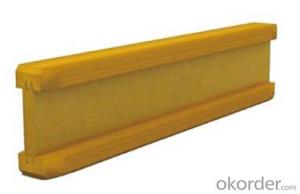Auto-climbing Bracket ACB100 & ACB50 for formwork and scaffolding systems
- Loading Port:
- Tianjin
- Payment Terms:
- TT OR LC
- Min Order Qty:
- 50 m²
- Supply Capability:
- 1000 m²/month
OKorder Service Pledge
OKorder Financial Service
You Might Also Like
Auto-climbing Bracket ACB100 & ACB50
The power of the auto-climbing formwork is the hydraulic system, which includes the oil cylinder
and two commutators. The commutators can control the climbing of climbing rail and the bracket.
The steel rail and the bracket can inter-climbing, so the whole system will climb up steadily.
Cranes are not needed during the construction. It’s easy to operate, highly efficient and safe. It’s
the best choice for the construction of high buildings and bridges.
There are mainly two types of standard auto-climbing brackets, ACB-50 and ACB-100, the figure
means the push power of cylinder with unit of KN.
Characteristics:
◆ Perfect load bearing anchor system
Anchor system is the most important supporting part. The system is made of five parts shown
below. Thereinto, tensile bolt, V-climbing cone and washer can be taken out for reusing after the
concrete pouring finished.There are two kinds of anchor systems,A & B. A is matched with single
anchor shoe and B is matched with double anchor shoe.
◆ Crane-independent
Crane-independent forming, striking and climbing speeds up the work procedures on the
construction site and also makes them independent of each other. This means the planned
sequences can be maintained along with guaranteeing high productivity levels. The crane can
therefore be used for other tasks.
Hydraulic system is mainly made of two commutators,
oil cylinder and power distribution system.The
commutators can control the climbing of climbing rail
and bracket.
◆ High bearing capacity and safe
The stable working platforms are able to carry large loads, e.g. the storage of reinforcing steel
for the next climbing section. Generously-sized working platforms, the well thought-out design for
handling very high wind loads and the patented control function of the climbing mechanism are
some of the special details contained within the comprehensive safety concept.
◆ Platforms adjusted to suit the angle of inclination
The horizontal working areas thus created provide safe and comfortable conditions for
reinforcement work, shuttering and striking, concreting and finishing.
◆ The ACB formwork system can climb not only vertically but also slantways, the largest angle is
18 degrees.
◆ The system can climb up wholly or separately. The climbing process is steady, synchronous
and safe.
◆ The bracket will not fall to the ground until the construction is finished, the field will be saved
and the impacting breakage will be reduced (especially the panel).
◆ The system will furnish omnidirectional platform, the construction organizations don’t need to
set up additional operation platform.
◆ The error of structure construction is small and easy to correct.
◆ The climbing speed is fast, the construction course will be quickened.
◆ The formwork can climb itself and cleaning work can be done in the same situs , the used times
of tower crane will be greatly reduced.

- Q: How does steel formwork prevent concrete leakage?
- Steel formwork prevents concrete leakage by providing a strong and rigid structure that holds the concrete in place during the pouring and curing process. The steel panels are tightly connected and sealed to form a watertight barrier, preventing any leakage or seepage of the concrete.
- Q: Can steel formwork be used for fire-resistant concrete structures?
- Fire-resistant concrete structures can indeed utilize steel formwork. Steel possesses exceptional strength and heat resistance, rendering it an optimal choice for constructing formwork in such cases. Furthermore, steel formwork presents several benefits, including longevity, reusability, and effortless assembly and disassembly. By offering essential support and containment during the pouring and curing processes, it guarantees the integrity and safety of the structure in the event of a fire. Nevertheless, it is crucial to acknowledge that the fire resistance of the concrete itself is contingent upon factors like mix design, aggregate selection, and thickness, rather than relying solely on the formwork material.
- Q: Can steel formwork be used for pre-stressed concrete elements?
- Pre-stressed concrete elements can indeed utilize steel formwork. Steel formwork is an adaptable and long-lasting alternative for the construction of such elements. It provides the necessary support and containment for the concrete throughout the pre-stressing process, ensuring the maintenance of its shape and strength. The suitability of steel formwork for pre-stressed concrete elements is due to its ability to bear substantial loads and withstand the forces and pressures involved in the pre-stressing process. Additionally, it enables precise control over the form and dimensions of the concrete element, guaranteeing accurate and consistent outcomes. Moreover, steel formwork is reusable, making it a cost-effective option for pre-stressed concrete construction projects. It can be easily assembled, disassembled, and adjusted to accommodate various shapes and sizes of pre-stressed elements. In conclusion, steel formwork is a suitable and commonly employed choice for the construction of pre-stressed concrete elements because of its strength, versatility, and cost-effectiveness.
- Q: How does steel formwork handle different concrete surface cleaning methods?
- Steel formwork is a durable and versatile option for concrete construction projects. When it comes to cleaning the concrete surface, steel formwork can handle various methods effectively. One common method of cleaning concrete surfaces is pressure washing. Steel formwork can withstand high-pressure water jets without any damage. The smooth and non-porous surface of steel formwork makes it easy to remove dirt, debris, and any other unwanted materials from the concrete surface. Pressure washing can effectively clean the surface, ensuring a smooth and even finish. Another method used for concrete surface cleaning is chemical cleaning. Steel formwork is resistant to most chemicals commonly used for cleaning purposes. This allows for the use of various cleaning agents to remove stubborn stains, oil, grease, and other contaminants from the concrete surface. The chemical cleaning process can be performed without causing any harm or degradation to the steel formwork. In some cases, manual cleaning methods may also be employed. Steel formwork can handle manual scrubbing, brushing, or scraping without any issues. The strength and durability of steel make it suitable for manual cleaning methods, which may be necessary for removing tough stains or debris that cannot be easily removed through other means. Overall, steel formwork is an ideal choice for handling different concrete surface cleaning methods. Its resistance to pressure washing, chemical cleaning, and manual cleaning methods ensures that the concrete surface can be effectively cleaned without causing any damage to the formwork. This allows for a clean and aesthetically pleasing finish, while also maintaining the structural integrity of the formwork.
- Q: Is steel formwork more environmentally friendly than other types of formwork?
- Steel formwork is generally considered to be more environmentally friendly than other types of formwork for several reasons. Firstly, steel is a highly durable material that can be reused multiple times, reducing the need for constant production of new formwork materials. This helps in conserving natural resources and reducing waste. Moreover, steel formwork has a longer lifespan compared to other materials like timber or plywood, which often degrade over time and need to be replaced frequently. This longevity reduces the overall consumption of formwork materials and the associated environmental impact. Additionally, steel formwork can be easily recycled at the end of its life, further reducing waste and minimizing the carbon footprint. The recycling process for steel is highly efficient and requires much less energy compared to the production of new steel, resulting in significant energy savings and reduced greenhouse gas emissions. Furthermore, steel formwork is resistant to moisture and other elements, reducing the need for chemical treatments to protect it from decay or damage. This reduces the release of harmful substances into the environment, making steel formwork a safer and more sustainable option. However, it's important to note that the environmental impact of steel formwork can also depend on factors such as the manufacturing processes used, transportation distances, and the specific project requirements. Therefore, it is crucial to consider the entire life cycle of the formwork and make informed decisions based on the specific circumstances to ensure the most environmentally friendly choice.
- Q: How does steel formwork impact the overall project execution?
- Steel formwork has a significant impact on the overall project execution in several ways. Firstly, steel formwork is known for its durability and strength, making it suitable for use in various construction projects. Its robust nature allows for multiple reuses, reducing the need for frequent replacements and lowering project costs. Additionally, steel formwork offers a high level of accuracy and precision in creating the desired shape and dimensions of concrete structures. This ensures that the final product meets the design specifications and minimizes any potential errors or defects. The ability to achieve precise and consistent results helps to streamline the construction process, saving time and effort. Furthermore, steel formwork provides excellent support and stability during the pouring and curing of concrete. Its rigid structure helps to prevent any deformation or displacement, ensuring that the concrete sets evenly and securely. This results in a structurally sound and stable finished product, enhancing the overall quality of the project. Moreover, steel formwork is versatile and adaptable, allowing for efficient customization to meet specific project requirements. It can be easily modified or adjusted to accommodate various shapes, sizes, and complexities of concrete structures. This flexibility enables contractors to work on projects with varying design specifications, reducing the need for multiple formwork systems and enhancing project efficiency. Lastly, steel formwork offers improved safety on construction sites. Its sturdy construction provides a stable working platform for workers, reducing the risk of accidents or injuries. Additionally, the use of steel formwork often requires fewer construction joints, resulting in a smoother and safer working environment. In conclusion, steel formwork plays a crucial role in the overall project execution by providing durability, accuracy, stability, versatility, and safety. Its impact extends beyond the construction phase, contributing to the long-term quality and success of the project.
- Q: How does steel formwork affect the aesthetics of a building?
- Steel formwork can significantly impact the aesthetics of a building in several ways. Firstly, steel formwork allows for complex and intricate designs to be created, resulting in visually appealing architectural elements. The flexibility and strength of steel allow for the construction of unique shapes, curves, and patterns that enhance the overall aesthetics of the building. Additionally, steel formwork provides a smooth and seamless finish to the concrete surfaces. This smooth finish contributes to a more refined and polished look, especially when compared to other types of formwork such as timber or plastic. The absence of visible joints, seams, or imperfections on the concrete surfaces enhances the overall appearance of the building. Moreover, steel formwork can be reused multiple times, resulting in cost savings and reduced waste. This economic advantage allows architects and designers to allocate more resources towards enhancing the aesthetics of the building, such as incorporating high-end finishes or unique decorative elements. Furthermore, steel formwork provides a high level of accuracy and precision during the construction process. This precision ensures that the final structure is aligned and symmetrical, enhancing the overall visual harmony of the building. Straight lines, sharp corners, and consistent dimensions can be achieved through the use of steel formwork, resulting in a visually pleasing and harmonious architectural design. Lastly, the durability and strength of steel formwork contribute to the longevity of the building's aesthetics. Steel formwork can withstand harsh weather conditions, resist corrosion, and maintain its structural integrity over time. This durability ensures that the building's aesthetics remain intact for an extended period, enhancing its overall appeal and value. In conclusion, steel formwork positively influences the aesthetics of a building by enabling complex designs, providing a smooth finish, allowing for precision and accuracy, offering cost savings, and ensuring long-lasting visual appeal.
- Q: What are the different components of steel formwork?
- Steel formwork is a type of temporary structure that is used in construction projects to provide support and shape to concrete during the curing process. It consists of several components that work together to create a rigid and durable formwork system. The main components of steel formwork include: 1. Panels: These are the primary components of the formwork system and are usually made of steel or steel-reinforced plywood. They are available in different sizes and shapes and can be easily interconnected to create the desired formwork configuration. 2. Soldiers: These are vertical members that provide support to the formwork panels. They are typically made of steel and are adjustable in height, allowing for flexibility in formwork design. Soldiers are connected to the panels using connecting clamps or pins. 3. Waler Beams: These are horizontal members that help distribute the load evenly across the formwork system. Waler beams are connected to the soldiers using clamps or brackets and are usually made of steel or aluminum. 4. Tie Rods: These are used to hold the formwork panels and soldiers together. They are threaded rods that pass through the panels and are secured with nuts and washers on each side. Tie rods help in maintaining the required spacing between the panels and provide additional strength to the formwork system. 5. Formwork Accessories: These include various components such as clamps, brackets, wedges, and pins that are used to connect and secure the formwork components. They help in maintaining the stability and alignment of the formwork system during concrete pouring and curing. 6. Formwork Joints: These are specially designed connectors that allow for easy assembly and disassembly of the formwork system. They ensure proper alignment and tightness of the formwork components, preventing leakage of concrete and maintaining the desired shape. 7. Formwork Supports: These are used to provide additional support to the formwork system, especially for larger and complex structures. Formwork supports can be in the form of props, scaffolding, or specialized shoring systems, depending on the specific requirements of the project. Overall, these components work together to create a strong and stable formwork system that can withstand the pressure and weight of the concrete during the construction process. Steel formwork is preferred for its durability, reusability, and ease of assembly and disassembly, making it a popular choice in modern construction projects.
- Q: Can steel formwork be used for industrial flooring?
- Yes, steel formwork can be used for industrial flooring. Steel formwork is known for its durability and strength, making it suitable for heavy-duty applications such as industrial flooring. It can withstand the weight and pressure exerted by heavy machinery and equipment, providing a stable and sturdy base for industrial operations. Additionally, steel formwork offers the advantage of being reusable, which makes it a cost-effective choice for flooring in industrial settings.
- Q: How does steel formwork affect the overall construction timeline?
- The overall construction timeline can be significantly influenced by steel formwork in various ways. Firstly, the durability and strength of steel formwork allow for quicker and more efficient construction processes. Unlike traditional timber formwork, steel formwork can be used multiple times, reducing the effort and time required for dismantling and reassembling. This reusability not only saves time but also reduces the need for additional materials, resulting in lower construction waste and costs. Moreover, steel formwork offers greater design and customization flexibility. Its versatility allows for the easy creation of complex shapes and structures, minimizing the need for extensive modifications or adjustments during construction. This flexibility not only saves time but also enhances overall construction efficiency. Furthermore, steel formwork provides faster concrete curing times due to better temperature and moisture control. This speeds up the concrete setting process and reduces the time needed for removing the formwork. As a result, the construction timeline is shortened, enabling earlier commencement of subsequent construction activities. Additionally, the high load-bearing capacity of steel formwork allows for the simultaneous construction of multiple floors. This parallel construction approach significantly expedites the construction process, reducing the overall timeline. However, it is important to note that although steel formwork offers numerous advantages, its initial setup and installation may require more time compared to other formwork materials. Proper alignment and securing of the steel formwork system may take longer than setting up traditional timber formwork. Nevertheless, this initial time investment is often compensated by the time saved during subsequent construction stages. In conclusion, steel formwork has a positive impact on the overall construction timeline. Its durability, reusability, flexibility, faster curing times, and high load-bearing capacity contribute to faster construction processes, reduced material waste, and increased construction efficiency. Despite the initial setup time, the benefits of steel formwork ultimately result in a more streamlined and accelerated construction timeline.
Send your message to us
Auto-climbing Bracket ACB100 & ACB50 for formwork and scaffolding systems
- Loading Port:
- Tianjin
- Payment Terms:
- TT OR LC
- Min Order Qty:
- 50 m²
- Supply Capability:
- 1000 m²/month
OKorder Service Pledge
OKorder Financial Service
Similar products
Hot products
Hot Searches




















